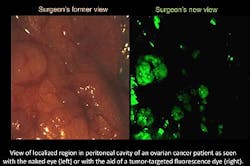Multispectral technique combines with fluorescing agent for targeted cancer surgery
A new imaging technique can help surgeons remove malignant tissue from patients suffering from ovarian cancer. The method -- created by Purdue University (West Lafayette, IN, USA) professor Philip Low -- illuminates cancer cells to help surgeons identify and remove small tumors that could otherwise be missed.
The technique involves attaching a green fluorescent imaging agent to a modified form of the vitamin folic acid, which acts as a "homing device" that seeks out and attaches itself to ovarian cancer cells. Patients are injected with the combination two hours prior to surgery.
When the patients’ cancerous tissue is then excited, it emits light that can be detected by a multispectral fluorescence camera developed at the Institute for Biological and Medical Imaging at the Technical University in Munich, Germany. The images from the camera are displayed on a flat-screen monitor next to the patient during an operation to assist surgeons in identifying and removing the tissue.
Low says that, using the technique, surgeons were able to see clusters of cancer cells as small as one-tenth of a millimeter, as opposed to the 3-mm-diameter cluster sizes that are detectable using current visual and tactile detection techniques.
The current imaging agent uses a green fluorescent dye with a relatively short wavelength that limits its ability to pass through the body, with the result that it cannot easily be imaged when present deep in tissue. To resolve that problem, Low plans to develop a red fluorescent imaging agent that will be able to be detected through the skin and deep into the body.
Aside from his academic work, Low is also chief science officer for Endocyte, a Purdue Research Park-based company that develops receptor-targeted therapeutics for the treatment of cancer and autoimmune diseases. Endocyte holds the license to the receptor-targeting technology and plans to bring it to market through a new company called OnTarget.
Vasilis Ntziachristos -- who led the Munich academic team that developed the multispectral fluorescence camera system -- plans to commercialize it through a startup called SurgOptix.
-- Posted by Vision Systems Design
